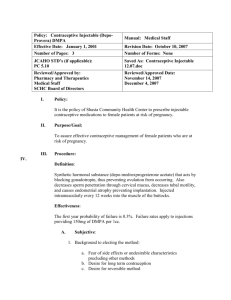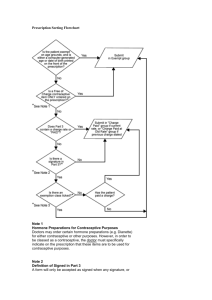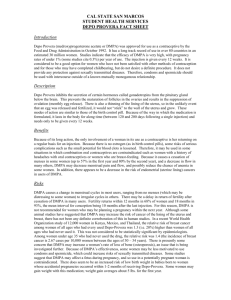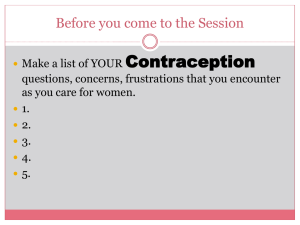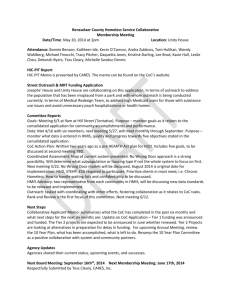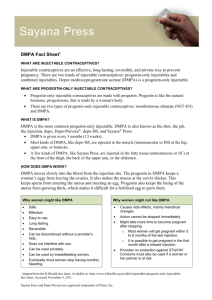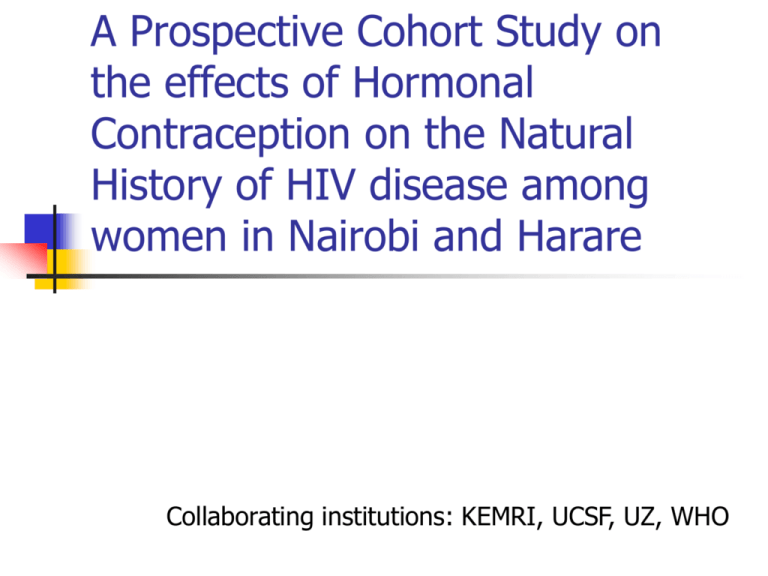
A Prospective Cohort Study on
the effects of Hormonal
Contraception on the Natural
History of HIV disease among
women in Nairobi and Harare
Collaborating institutions: KEMRI, UCSF, UZ, WHO
Background
As of 2005, approx 18M women were HIVinfected worldwide and 80% in sub-Saharan
Africa
100M globally use hormonal contraception
Increasing HC use in HIV prevalent areas
Effective contraception, a preventive tool for
unintended pregnancies and in reducing
proportion of HIV-infected children
Potential Interactions between
steroid hormones and HIV
Plausible mechanisms for HIV-HC
interactions
Direct effects
Binds directly to the HIV regulatory protein and enhances
replication hence increasing viral load
Indirect effects
Influencing both humoral and cell-mediated by either
increasing or decreasing various cytokines
Previous studies
Hunt J et al, 1998 described a direct effect on virus expression via
hormone response elements within the HIV-1 promoter.
Marx et al, 1996 described an SIV macaque model and demonstrated
increased infectivity with Progesterone treatment (thinning of the
vaginal epithelium.
Lavreys L, et al, 2003 found that DMPA use at the time of HIV-1
acquisition and the presence of a GUD during the early phase of
infection were associated with higher levels of HIV-1 replication.
Martin H et al, 1998 reported increased HIV-1 acquisition and other STI
among women (CSW) using DMPA
Sagar M et al, 2003 reported an association of COC use at the time of HIV-1
infection with increased risk of acquiring multiple HIV-1 genotypes leading to
higher viral set points and rapid progression
Justification
Previous studies have demonstrated effects of
hormones in animal models and among high
risk populations
Currently limited data exists on the effects of
HC on HIV progression among women in the
general population
Increasing concern among health care
providers on the possibility of rapid disease
progression among HIV infected women
using HC methods
Overall Objective
To determine the effects of hormonal
contraception on HIV-1 disease
progression among women in Nairobi and
Harare
Specific Objectives
To determine the effects of COC and
DMPA on the rate of CD4 decline
To determine the effects of COC and
DMPA on WHO clinical staging
To determine the effects of COC and
DMPA on plasma viral load
Methods
Study Design: Prospective Cohort Study (2000-2005)
Study Sites: Nairobi, Kenya and Harare, Zimbabwe
Study Population: HIV-1 infected women aged 18-49yrs
presenting to FP facilities with CD4 count >500
cells/µL and on self selected FP method (COC, DMPA,
non-Hormonal contraceptive methods) for at least 3
months
Clinical and Laboratory
procedures
At enrolment and every 6 month follow up visit:
a medical history including social, sexual,
contraceptive and examination performed
using a structured questionnaire
Hemogram, RPR, CD4 count, plasma viral
load measurement
Annual pap smear test
Data Analysis
A Univariate comparison of baseline characteristics was done by
COC, DMPA vs. non-HC methods. Potential confounding was
controlled for all multivariate models.
Survival Analysis (univariate comparison of mean change in CD4
counts by contraceptive method over time).
Linear Mixed Effects Models, multivariate analysis of the rate of
CD4 decline by contraceptive method.
Cox Proportional Hazards Models (Multivariate analysis of
factors associated with time to advanced HIV disease stages (III
and IV).
Considered two scenarios: 1) Analysis of outcomes while
excluding non compliant contraceptive users and 2) the
intention to treat analysis, included all non-compliant subjects
Results
A total of 498 women enrolled beginning the
year 2000 and followed through to 2005
Median follow up of 2 (0-4) years
Mean age of 27.45 (5.3) years
77% were married
Fig 1: Patient enrolment
and follow up flow chart
Total number of subjects enrolled:
498
Nairobi: 302 (60.6%)
Harare: 196(39.4%)
Total number excluded from
analysis
9 (1.8%) women on Norplant
Overall with contraceptive change
for both sites
127 (25.6%)
Nairobi: 7 (1.4%)
Harare: 2 (0.4%)
DMPA/COC to non-HC: 36 (28.3%)
Non-HC to COC/DMPA: 39 (30.7%)
Vice versa: 14 (11%)
Pregnant: 38 (29.9%)
Overall number analyzed by contraceptive method and
site: 336 (%)
Nairobi: 217 (59.3%)
Harare: 149 (40.7%)
COC: 36 (16.6%)
COC=54(36.2%)
DMPA: 98 (45.2%)
DMPA: 46 (30.9%)
Non-HC: 83(38.2%)
Non-HC: 49(32.9%)
Overall Outcomes by Contraceptive Method
4 (1.1%) of deaths
COC:0 (0%)
DMPA: 3( 75%)
Non–HC:1 (25%)
27 (7.4%) with CD4 <200 cells/µL in 4 years
COC: 2(7.4%)
DMPA: 15(55.6%)
Non-HC: 10(37%)
Table 1: Sociodemograhic characteristics by
contraceptive method among HIV-1 infected
women in Nairobi and Harare
Characteristic
COC
N= 90 (24.7%)
DMPA
N= 144 (39.2%)
Non-HC
N= 132 (36.2%)
Study site:
Kenya
Zimbabwe
36(40.0%)
54(60.0%)
98(68.1%)
46(31.9%)
83(62.9%)
49(37.1%)
0.000
Mean age (sd) yrs
27.5 (5.31)
26.2(4.5)
29.9 (6.56)
0.000
Education
None
Primary
Secondary
College
0 (0%)
38(42.2%)
51(56.7%)
1(1.1%)
1 (0.7%)
66 (46.2%)
75 (52.4%)
1 (0.7%)
4 (3.0%)
44 (33.3%)
66 (50.0%)
18 (13.6%)
0.000
Marital Status
Single (never married)
Married (cohabiting)
Regular partn(not cohabiting)
Divorced/separated/widowed
0(0%)
84(93.3%)
4 (4.4%)
2 (2.2%)
2 (1.4%)
126 (87.5%)
9 (6.3%)
7 (4.9%)
12
66
21
32
0.000
Current smoker
2 (2.2%)
3 (2.1%)
11(8.3%)
0.028
Currrent alcoholic drinks
23(25.6%)
25(17.4%)
47(35.6%)
0.003
(9.2%)
(50.4%)
(16.0%)
(24.4%)
P-value
Table 1 continued: Sexual history by
contraceptive method
Characteristic
COC
DMPA
Non-HC
P-value
Mean (sd) age of sexual debut
(yrs)
17.8 (2.54)
16.87(2.44)
17.7(2.94)
0.02
37 (41.1%)
39 (43.3%)
13 (14.4%)
1 (1.1%)
38(26.4%)
69(47.9%)
35(24.3%)
2(1.4%)
31(23.5%)
53(40.2%)
34(25.8%)
14(10.6%)
0.000
Never
Less than half
More than half
always
60 (68.2%)
7 (8.0%)
9 (10.2%)
12(13.6%)
95 (78.5%)
10 (8.3%)
5 (4.1%)
11 (9.1%)
13 (17.6%)
3 (4.1%)
4 (5.4%)
54(73.0%)
0.000
Currently having other sexual
partners
2(2.2%)
3(2.1%)
20(15.2%)
0.000
No of lifetime sexual partners
One
2-3
4-10
11 and more
Condom use with regular
partner
Table 1 continued: Sexual, reproductive history
and Clinical parameters by contraceptive method
Characteristic
COC
DMPA
Non-HC
P-value
Ever exchanged sex for money or
gifts
2(2.2%)
4(2.8%)
20(15.2%)
0.000
37 (41.1%)
39 (43.3%)
13 (14.4%)
1 (1.1%)
38 (26.4%)
69 (47.9%)
35 (24.3%)
2 (1.4%)
31(23.5%)
53 (40.2%)
34 (25.8%)
14 (10.6%)
0.000
Reproductive history
Currently breastfeeding
Median (range) number of births
24 (26.7%)
2 (1-5)
57 (39.6%)
2 (1-6)
16 (12.2%)
2 (0-8)
0.000
CD4 count, median (range)
639 (502 -1457)
684 (505-1383)
630 (500-1689)
0.343
Baseline WHO clinical stages
WHO stage I
WHO stage II
80 (88.9%)
10 (11.1%)
126 (87.5%)
18 (12.5%)
117(90.0%)
13 (10.0%)
0.807
Lifetime number of sexual partners:
One
2-3
4-10
11 or more
Table 2: Multivariate analysis of the association of
contraceptive use on CD4 count decline among HIV-1
infected women in Nairobi and Harare
Characteristic
Estimate (95% CI)
P-value
Study site
Kenya
Zimbabwe
0.015 (-0.066, 0.096)
ref
0.719
-
Age (mean, SD) years
-0.001 (-0.008, 0.006)
0.749
Contraceptive method
COC
DMPA
Non-HC
-0.266 (-0.612, 0.081)
-0.145 (-0.426, 0.137)
ref
0.133
0.313
-
Baseline CD4 count
0.001 (0.000, 0.002)
0.024
WHO Disease Staging
Stage I
Stage II
Advanced stage
0.464 (-0.223, 1.152)
0.198 (-0.511, 0.908)
ref
0.185
0.584
-
Age of sexual debut
-0.017 (-0.032, -0.003)
0.019
Table 3: Multivariate analysis of the association of
contraceptive use with time to advanced WHO clinical
stages among HIV-1 infected women in Nairobi and Harare
Covariate
Adjusted HR
(95%CI)
P-value
Study site
Kenya
Zimbabwe
0.30 (0.11, 0.82)
ref
.018
-
Age (years)
1.12 (1.03, 1.21)
.006
Contraceptive method
COC
DMPA
Non-HC
0.91 (0.25, 3.27)
0.56 (0.19, 1.64)
ref
0.883
0.290
-
Initial CD4 count
0.994 (0.990, 0.999)
0.021
1.84(0.12, 27.63)
0.12 (0.02, 0.88)
0.32 (0.05, 1.87)
ref
0.658
0.038
0.205
-
Education level
None
Primary
Secondary
Post Secondary
Table 3 continued….: Multivariate analysis of the
association of contraceptive use with time to advanced
disease
Covariate
HR (95% CI)
P-value
Had support from friends
1.56 (0.58, 4.22)
0.378
Had support from other groups
1.57 (0.55, 4.49)
0.400
Let others know of their HIV status
0.28 (0.10, 0.78)
0.015
Body weight
0.95 (0.91, 0.99)
0.010
0.98 (0.81, 1.18)
1.86 (0.62, 0.77)
0.21 (0.06, 0.77)
0.804
0.271
0.019
Psychosocial characteristics
Sexual and social behavior
Age of sexual debut
Taking alcoholic beverages
Exchanged sex for gifts
Fig 2: Kaplan Meier Curves for survival to advanced WHO
clinical stages by contraceptive method
1.1
1.0
Method
Non-hormonal
.9
DMPA
.8
COC
.7
0
1
2
Time in years
3
4
5
Slopes of mean CD4 count by hormonal
contraceptive method
100
0
-100
Method
Combined pills
-200
DMPA
Non-hormonal
-300
.00
.50
1.00
1.50
2.00
2.50
3.00
3.50
4.00
Mean change in CD4 count by
contraceptive method
100
0
-100
Method
Combined pills
-200
Mean change in CD4
100
0
-100
Me
-200
DMPA
Non-hormonal
-300
.00
.50
1.00
1.50
2.00
2.50
Follow-up visit (in yrs))
3.00
3.50
4.00
-300
.00
.50
1.00
1.50
2.00
2.50
3.00
Follow-up visit (in yrs))
3.50
4.00
Kaplan Meier curves on time to WHO
advanced disease stages (intent-to-treat
analysis)
1.02
1.1
1.00
1.0
Method
Non-hormonal
.9
Metho
.98
non-horm
.96
.94
DMPA
dmpa
.92
.8
.90
combined
COC
.88
.7
0
1
2
3
Time in years
4
5
0
1
2
3
4
Time to advanced disease (yrs)
5
Comparison of analyses of the effect of contraceptive on
CD4 count decline: intent-to treat analysis vs. per exposure
analysis
Intent-to-treat Analysis
Characteristic
Per exposure Analysis
Estimate
cells/µL/yr
(95%CI)
Pvalue
0.268(0.0173,
0.362)
0.215(0.111,0.320)
-ref
<0.001
Advanced stage
Estimate
cells/µL(95%CI)
Pvalue
0.464(-0.223,
1.152)
0.185
WHO clinical
stages
WHO clinical
stages
I
II
Characteristic
<0.001
I
II
Advanced stage
0.584
0.198(-0.511,
0.908)
-ref
Comparison of Multivariate analysis on the effect
of HC on time to advanced WHO clinical stages:
intent-to-treat vs. per exposure analysis
Intent-to-treat analysis
Characteristic
HR (95%CI)
Per exposure analysis
Pvalue
Country
Characteristic
HR (95%CI)
P-value
Kenya
0.30 (0.11, 0.82)
0.018
Zimbabwe
Ref
Ever exchanged
sex for gifts
0.21 (0.06, 0.77)
Country
Kenya
0.69 (0.29, 1.69)
Zimbabwe
Ref
Ever exchanged
sex for gifts
0.310 (0.095, 1.011)
0.427
0.052
0.019
Pending Analysis
Effects of HC on Plasma viral load
Effects of COC vs. DMPA on CD4 decline
Study Limitations
Switching from one contraceptive
method to another
Stringent inclusion criteria thereby
missing women who were likely faster
progressors
Follow up period shorter to attain study
endpoints
Discussion
Differences in baseline CD4 counts and time
to advanced WHO stages by country
CD4 decline compared to other natural
history studies
Non-HC group risky sexual and social
behavior
Why findings differ from those among high
risk populations: issues of residual
confounding in terms of sexual practice or
STI
Discussion
Factors significantly associated with
CD4 decline, faster progression to
advanced WHO clinical stages:
Baseline CD4 count, age of sexual
debut, age and body weight
Summary
Findings suggest that COC and DMPA have no
effects on HIV-1 progression among women
attending FP facilities in Nairobi and Harare
Baseline CD4 and age of sexual debut were
associated with the rate of CD4 decline.
Older age and body weight were associated
with faster progression to advanced WHO
clinical stages
Summary
These findings will contribute to
findings that HIV-1 infected women
using either COC or DMPA are not at
increased risk of rapid disease
progression compared to their
counterparts using non hormonal
contraceptive methods
Acknowledgements
Dr. Craig Cohen (UCSF)
Dr. Tsungai Chipato (UZ)
Tim Farley (WHO)
Estie Hudes (CAPS, UCSF)
Research teams (Kenya and Zimbabwe)
Study participants
Collaborating institutions (UCSF,KEMRI, UZ)
and funding orgs (WHO, CFAR)

